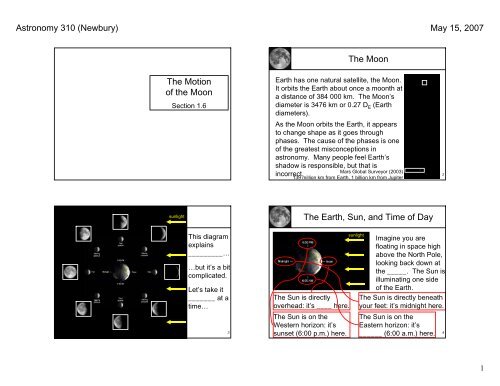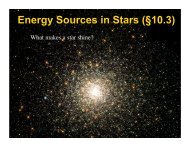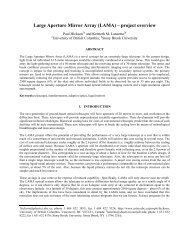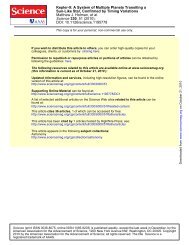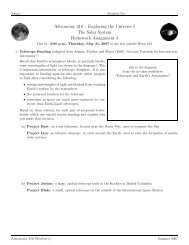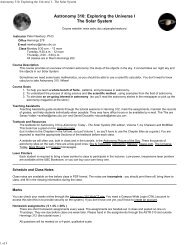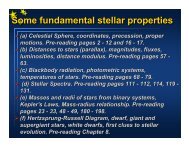The Motion of the Moon The Moon The Earth, Sun, and Time of Day
The Motion of the Moon The Moon The Earth, Sun, and Time of Day
The Motion of the Moon The Moon The Earth, Sun, and Time of Day
- No tags were found...
Create successful ePaper yourself
Turn your PDF publications into a flip-book with our unique Google optimized e-Paper software.
Astronomy 310 (Newbury)<br />
May 15, 2007<br />
<strong>The</strong> <strong>Motion</strong><br />
<strong>of</strong> <strong>the</strong> <strong>Moon</strong><br />
Section 1.6<br />
<strong>The</strong> <strong>Moon</strong><br />
<strong>Earth</strong> has one natural satellite, <strong>the</strong> <strong>Moon</strong>.<br />
It orbits <strong>the</strong> <strong>Earth</strong> about once a moonth at<br />
a distance <strong>of</strong> 384 000 km. <strong>The</strong> <strong>Moon</strong>’s<br />
diameter is 3476 km or 0.27 D E (<strong>Earth</strong><br />
diameters).<br />
As <strong>the</strong> <strong>Moon</strong> orbits <strong>the</strong> <strong>Earth</strong>, it appears<br />
to change shape as it goes through<br />
phases. <strong>The</strong> cause <strong>of</strong> <strong>the</strong> phases is one<br />
<strong>of</strong> <strong>the</strong> greatest misconceptions in<br />
astronomy. Many people feel <strong>Earth</strong>’s<br />
shadow is responsible, but that is<br />
Mars Global Surveyor (2003)<br />
incorrect.<br />
139 million km from <strong>Earth</strong>, 1 billion km from Jupiter<br />
2<br />
sunlight<br />
<strong>The</strong> <strong>Earth</strong>, <strong>Sun</strong>, <strong>and</strong> <strong>Time</strong> <strong>of</strong> <strong>Day</strong><br />
This diagram<br />
explains<br />
_________…<br />
…but it’s a bit<br />
complicated.<br />
Let’s take it<br />
_______ at a<br />
time…<br />
3<br />
<strong>The</strong> <strong>Sun</strong> is directly<br />
overhead: it’s ____ here.<br />
<strong>The</strong> <strong>Sun</strong> is on <strong>the</strong><br />
Western horizon: it’s<br />
sunset (6:00 p.m.) here.<br />
sunlight<br />
Imagine you are<br />
floating in space high<br />
above <strong>the</strong> North Pole,<br />
looking back down at<br />
<strong>the</strong> _____. <strong>The</strong> <strong>Sun</strong> is<br />
illuminating one side<br />
<strong>of</strong> <strong>the</strong> <strong>Earth</strong>.<br />
<strong>The</strong> <strong>Sun</strong> is directly beneath<br />
your feet: it’s midnight here.<br />
<strong>The</strong> <strong>Sun</strong> is on <strong>the</strong><br />
Eastern horizon: it’s<br />
4<br />
______ (6:00 a.m.) here.<br />
1
Astronomy 310 (Newbury)<br />
May 15, 2007<br />
<strong>The</strong> Orbiting <strong>Moon</strong><br />
<strong>Moon</strong> Phases<br />
one side<br />
dark<br />
sunlight<br />
one side lit<br />
by sunlight<br />
<strong>Moon</strong><br />
<strong>The</strong> <strong>Moon</strong> orbits<br />
around <strong>the</strong> <strong>Earth</strong><br />
every ______days.<br />
<strong>The</strong> <strong>Sun</strong> always<br />
illuminates one<br />
side <strong>of</strong> <strong>the</strong> <strong>Moon</strong>,<br />
<strong>the</strong> side towards<br />
<strong>the</strong> <strong>Sun</strong>, no matter<br />
where <strong>the</strong> <strong>Moon</strong> is<br />
in ________.<br />
<strong>The</strong> big question is, what does <strong>the</strong> <strong>Moon</strong> look like<br />
_____________ throughout <strong>the</strong> orbit<br />
<strong>The</strong> key point is realizing we do not always see <strong>the</strong><br />
________ <strong>of</strong> <strong>the</strong> <strong>Moon</strong>. <strong>The</strong> amount <strong>of</strong> <strong>the</strong> sunlit half<br />
we see depends on where <strong>the</strong> <strong>Moon</strong> is in it’s orbit.<br />
see all dark,<br />
sliver <strong>of</strong> lit<br />
sunlight<br />
5<br />
We see <strong>the</strong> new <strong>Moon</strong> during <strong>the</strong> day (but not ______).<br />
6<br />
Waxing Crescent<br />
<strong>Earth</strong>shine<br />
see mostly dark<br />
but some<br />
lit, too<br />
sunlight<br />
Sometime <strong>the</strong>re is so much light reflected back <strong>of</strong>f <strong>the</strong><br />
______ <strong>and</strong> on <strong>the</strong> <strong>Moon</strong> that we can see <strong>the</strong> “_____”<br />
portion <strong>of</strong> <strong>the</strong> <strong>Moon</strong>. We call this <strong>Earth</strong>shine.<br />
One ______ <strong>of</strong> <strong>the</strong> way through <strong>the</strong> cycle (3 – 4 days)<br />
we see a crescent <strong>Moon</strong> (in <strong>the</strong> evening). <strong>The</strong><br />
crescent “points” towards <strong>the</strong> <strong>Sun</strong>. <strong>The</strong> crescent is<br />
______ every day, so it’s called <strong>the</strong> waxing crescent.<br />
7<br />
Rychlik<br />
8<br />
2
Astronomy 310 (Newbury)<br />
May 15, 2007<br />
First Quarter<br />
Surface <strong>of</strong> <strong>the</strong> <strong>Moon</strong><br />
half<br />
dark<br />
half<br />
lit<br />
sunlight<br />
One quarter <strong>of</strong> <strong>the</strong> way through <strong>the</strong> cycle (_____) we<br />
see half <strong>the</strong> <strong>Moon</strong> lit (<strong>and</strong> half dark). We still call it<br />
<strong>the</strong> first ______ <strong>Moon</strong>, though, because <strong>of</strong> its position<br />
in <strong>the</strong> lunar cycle.<br />
9<br />
<strong>The</strong> <strong>Moon</strong> has no atmosphere to scatter <strong>and</strong> bend <strong>the</strong><br />
sunlight, like we do here on <strong>Earth</strong>. So, when <strong>the</strong> <strong>Sun</strong><br />
sets or you’re in a shadow (on <strong>the</strong> <strong>Moon</strong>) it’s ______<br />
______. And when <strong>the</strong> <strong>Sun</strong> is visible, it’s as bright as<br />
<strong>the</strong> middle <strong>of</strong> <strong>the</strong> day.<br />
<strong>The</strong> line between night <strong>and</strong> day on<br />
<strong>the</strong> <strong>Moon</strong> is called <strong>the</strong> __________.<br />
Using binoculars or a telescope, you<br />
can clearly see <strong>the</strong> surface <strong>of</strong> <strong>the</strong><br />
<strong>Moon</strong> is not smooth, but that it’s<br />
covered in craters. Around first<br />
quarter is <strong>the</strong> _____ time for looking. Lammel<br />
10<br />
Waxing Gibbous<br />
Full <strong>Moon</strong><br />
but mostly lit<br />
sunlight<br />
<strong>Moon</strong> all lit<br />
sunlight<br />
some<br />
dark<br />
About 10 days into <strong>the</strong> lunar cycle, <strong>the</strong> ______ side <strong>of</strong><br />
<strong>the</strong> <strong>Moon</strong> is still growing. It’s called a waxing gibbous<br />
(“________” means “humped” or “bulging”).<br />
11<br />
can’t see any<br />
<strong>of</strong> <strong>the</strong> dark side<br />
________ through <strong>the</strong> cycle (2 weeks) <strong>the</strong> <strong>Moon</strong> is full.<br />
You only see <strong>the</strong> full <strong>Moon</strong> from <strong>the</strong> night-side <strong>of</strong> <strong>Earth</strong><br />
(it rises in <strong>the</strong> East at sunset <strong>and</strong> sets in <strong>the</strong> West at<br />
sunrise.)<br />
Wait a minute! Won’t <strong>the</strong> <strong>Earth</strong> ______ <strong>the</strong> sunlight<br />
No, not every lunar cycle. We’ll discuss lunar ______<br />
12<br />
in <strong>the</strong> next section…<br />
3
Astronomy 310 (Newbury)<br />
May 15, 2007<br />
Waxing Gibbous<br />
Third Quarter<br />
sunlight<br />
some<br />
dark<br />
one side<br />
mostly lit<br />
sunlight<br />
one<br />
half<br />
dark<br />
one<br />
half lit<br />
After <strong>the</strong> Full moon, <strong>the</strong> sunlit portion <strong>of</strong> <strong>the</strong> <strong>Moon</strong><br />
begins to get smaller (begins to “_______”). It’s still<br />
gibbous, so we see <strong>the</strong> waning gibbous <strong>Moon</strong> early in<br />
<strong>the</strong> _________.<br />
13<br />
Three quarters <strong>of</strong> <strong>the</strong> way through <strong>the</strong> cycle, about 3<br />
weeks, we see <strong>the</strong> ________ half <strong>the</strong> <strong>Moon</strong> lit <strong>and</strong> <strong>the</strong><br />
o<strong>the</strong>r half _______. This is <strong>the</strong> third quarter <strong>Moon</strong>.<br />
14<br />
Waning Crescent<br />
New <strong>Moon</strong>, Again<br />
After 29.5 days, <strong>the</strong> ______ starts over again…<br />
mostly dark<br />
a bit<br />
lit, too<br />
sunlight<br />
new <strong>Moon</strong><br />
very young<br />
<strong>Moon</strong><br />
Near <strong>the</strong> end <strong>of</strong> <strong>the</strong> lunar cycle, we see only a<br />
_______ (pointing towards <strong>the</strong> <strong>Sun</strong>). <strong>The</strong> crescent is<br />
getting smaller each day, giving a waning crescent<br />
<strong>Moon</strong>. We see it in <strong>the</strong> morning – just before ______<br />
is best.<br />
15<br />
very end<br />
<strong>of</strong> cycle<br />
16<br />
4
Astronomy 310 (Newbury)<br />
May 15, 2007<br />
sunlight<br />
See how<br />
easy it is<br />
now _____!<br />
Eclipses<br />
<strong>The</strong>re is a lot<br />
<strong>of</strong> information<br />
_____ inside<br />
this diagram!<br />
17<br />
APOD 2006 April 4<br />
APOD 2006 April 4<br />
Recall <strong>the</strong> Full <strong>Moon</strong>…<br />
Eclipses<br />
sunlight<br />
Eclipses <strong>of</strong> <strong>the</strong> <strong>Sun</strong> <strong>and</strong> <strong>Moon</strong> are (<strong>the</strong> most)<br />
spectacular astronomical events. Solar eclipses, as<br />
we’ll see shortly, are difficult to see, so if you’ve ever<br />
seen a total solar eclipse, you are _____________.<br />
Recall that when <strong>the</strong> <strong>Moon</strong> on <strong>the</strong> side <strong>of</strong> <strong>the</strong> <strong>Earth</strong><br />
__________ <strong>the</strong> <strong>Sun</strong>, we see a full <strong>Moon</strong>.<br />
An obvious question is, doesn’t <strong>the</strong> <strong>Earth</strong> ________<br />
________ <strong>The</strong> answer is yes, sometimes, but not<br />
every lunar cycle. Eclipses require special alignment.<br />
19<br />
solar eclipse (August 1999)<br />
APOD 2006 March 30<br />
A solar eclipse occurs when<br />
<strong>the</strong> <strong>Earth</strong> passes into <strong>the</strong><br />
________ <strong>of</strong> <strong>the</strong> <strong>Moon</strong>. <strong>The</strong><br />
<strong>Moon</strong> blocks <strong>the</strong> <strong>Sun</strong>, as<br />
seen from <strong>Earth</strong>. It happens<br />
only when <strong>the</strong> ______, <strong>Moon</strong><br />
<strong>and</strong> <strong>Earth</strong> are aligned.<br />
20<br />
5
Astronomy 310 (Newbury)<br />
May 15, 2007<br />
Eclipses<br />
Lunar Eclipses<br />
A ______ eclipse occurs when<br />
<strong>the</strong> <strong>Moon</strong> passes into <strong>the</strong><br />
<strong>Earth</strong>’s shadow. <strong>Earth</strong> ______<br />
<strong>the</strong> sunlight that is supposed to<br />
produce a full <strong>Moon</strong>. It<br />
requires alignment <strong>of</strong> <strong>the</strong> <strong>Sun</strong>,<br />
<strong>Earth</strong> <strong>and</strong> <strong>Moon</strong>.<br />
Did you notice <strong>the</strong> ________<br />
An eclipse is named after…<br />
<strong>the</strong> object<br />
being blocked<br />
lunar eclipse (November 2003)<br />
APOD 2003 November 21<br />
<strong>the</strong> object doing<br />
It seems like <strong>the</strong>re should be a lunar eclipse ______<br />
_______ when <strong>the</strong> <strong>Moon</strong> is full. This doesn’t happen,<br />
though, because <strong>the</strong> <strong>Moon</strong>’s orbit is ____ about 5°<br />
from <strong>the</strong> plane <strong>of</strong> <strong>the</strong> Solar System.<br />
Because <strong>of</strong> <strong>the</strong><br />
tilt, sometimes <strong>the</strong><br />
<strong>Moon</strong> is above<br />
<strong>the</strong> ecliptic <strong>and</strong><br />
sometimes it’s<br />
below <strong>the</strong> ecliptic.<br />
Eclipses are not<br />
<strong>the</strong> blocking 21<br />
________.<br />
22<br />
Line <strong>of</strong> Nodes<br />
Lunar Eclipse Y or N<br />
Notice <strong>the</strong>re are<br />
two points on <strong>the</strong><br />
<strong>Moon</strong>’s orbit where<br />
it _____________<br />
<strong>the</strong> plane. <strong>The</strong>se<br />
points are on <strong>the</strong><br />
line <strong>of</strong> nodes.<br />
In order for a lunar eclipse to occur, <strong>the</strong> ___________<br />
must be on <strong>the</strong> line <strong>of</strong> nodes at exactly <strong>the</strong> same time<br />
<strong>the</strong> <strong>Earth</strong> is in <strong>the</strong> right place in it’s orbit that <strong>the</strong> line <strong>of</strong><br />
nodes points towards __________:<br />
23<br />
24<br />
6
Astronomy 310 (Newbury)<br />
May 15, 2007<br />
Three Types <strong>of</strong> Lunar Eclipses<br />
<strong>The</strong> <strong>Earth</strong>’s Shadow<br />
It requires amazing alignment <strong>of</strong> <strong>the</strong> <strong>Sun</strong>, <strong>Earth</strong> <strong>and</strong><br />
<strong>Moon</strong> to produce a lunar eclipse. It doesn’t have to<br />
be ______________, though, because <strong>the</strong> <strong>Sun</strong>, <strong>Earth</strong><br />
<strong>and</strong> <strong>Moon</strong> are not infinitely small points. <strong>The</strong>y have<br />
some size, so <strong>the</strong>re is a some “leeway” for almost<br />
perfect alignment.<br />
This leeway means <strong>the</strong>re are _______ lunar eclipses<br />
each year. Depending on how ____ <strong>the</strong> alignment is,<br />
three different kinds <strong>of</strong> lunar eclipses can occur…<br />
25<br />
First, ________ <strong>the</strong><br />
shape <strong>of</strong> <strong>the</strong> <strong>Earth</strong>’s<br />
shadow:<br />
Pogge<br />
(Ohio State)<br />
<strong>The</strong> region behind <strong>Earth</strong> that receives __________ is<br />
called <strong>the</strong> umbra (“umbra” means “shadow”, as in<br />
“umbrella”). Because <strong>the</strong> <strong>Sun</strong> is so huge, <strong>the</strong>re are<br />
regions that get some sunlight, but not all <strong>of</strong> it. This is<br />
<strong>the</strong> penumbra (<strong>the</strong> prefix “pen-” means “almost”, as in<br />
__________, an “almost isl<strong>and</strong>”)<br />
26<br />
If <strong>the</strong> full <strong>Moon</strong><br />
passes only<br />
through <strong>the</strong><br />
penumbra, it is only<br />
partially blocked.<br />
Penumbra Lunar Eclipse<br />
If <strong>the</strong> __________<br />
passes through <strong>the</strong><br />
umbra, it is totally<br />
blocked, producing<br />
a ___ lunar eclipse<br />
Total Lunar Eclipse<br />
<strong>The</strong>re may still be a significant amount <strong>of</strong> _________<br />
hitting <strong>the</strong> <strong>Moon</strong>. Sometimes, you ______________ a<br />
penumbral lunar eclipse is happening.<br />
27<br />
28<br />
7
Astronomy 310 (Newbury)<br />
May 15, 2007<br />
Why is <strong>the</strong> lunar eclipse red<br />
<strong>The</strong> <strong>Moon</strong> may be directly behind <strong>the</strong> <strong>Earth</strong>, but it is<br />
not completely dark because <strong>the</strong> <strong>Earth</strong>’s __________<br />
bends <strong>the</strong> sunlight onto <strong>the</strong> <strong>Moon</strong>: refraction<br />
Sure, but why is it ___ <strong>The</strong> <strong>Earth</strong>’s atmosphere also<br />
scatters away shorter wavelength light (blue) leaving<br />
<strong>the</strong> _____ wavelengths (red) to travel on to <strong>the</strong> <strong>Moon</strong>.<br />
red <strong>and</strong> blue mixed<br />
blue<br />
red<br />
Next Lunar Eclipse<br />
<strong>The</strong> length <strong>of</strong> time <strong>the</strong> <strong>Moon</strong> spends eclipsed by <strong>the</strong><br />
<strong>Earth</strong> depends on its _____through <strong>the</strong> umbra. It can<br />
last for up to 1:47 hours.<br />
<strong>The</strong> next total lunar<br />
eclipse is on August 28.<br />
We should be able to<br />
______ <strong>the</strong> whole event<br />
from here in Vancouver.<br />
This is a long-exposure picture that shows <strong>the</strong><br />
fainter, redder light during <strong>the</strong> eclipse.<br />
29<br />
Espenak (Mr. Eclipse)<br />
30<br />
If <strong>the</strong> full <strong>Moon</strong><br />
passes partly<br />
through <strong>the</strong> umbra,<br />
it is only ________<br />
blocked.<br />
Partial Lunar Eclipse<br />
<strong>The</strong> portion <strong>of</strong> <strong>the</strong> <strong>Moon</strong> in <strong>the</strong> umbra may turn quite<br />
dark (or red). <strong>The</strong> portion only in <strong>the</strong> penumbra may<br />
still be _____, though, producing a partial lunar eclipse.<br />
How Good is <strong>the</strong> Alignment, Anyway<br />
Imagine making a scale model <strong>of</strong> a lunar eclipse.<br />
<strong>The</strong> important quantities are:<br />
Quantity<br />
Length (km) Scale to <strong>Moon</strong> pinky fingernail<br />
<strong>Moon</strong> diameter<br />
3475 1<br />
1 cm<br />
<strong>Earth</strong> diameter<br />
12 756 3.67 3.67 cm<br />
<strong>Sun</strong> diameter 1 392 530 400.7 400 cm (____)<br />
<strong>Earth</strong>-<strong>Moon</strong> distance 384 400 110.6 111 cm (1.1 m)<br />
<strong>Earth</strong>-<strong>Sun</strong> distance 149 600 000 43 050 __________<br />
(______ m)<br />
1 392 530<br />
= 400.7<br />
3475<br />
31<br />
32<br />
8
Astronomy 310 (Newbury)<br />
May 15, 2007<br />
How Good is <strong>the</strong> Alignment, Anyway<br />
Quantity<br />
Scale to <strong>Moon</strong> head <strong>of</strong> a pin<br />
<strong>Moon</strong> diameter<br />
1<br />
1 mm<br />
<strong>Earth</strong> diameter 3.67 3.67 mm<br />
<strong>Sun</strong> diameter 400.7 400 mm (40 cm)<br />
<strong>Earth</strong>-<strong>Moon</strong> distance 110.6 111 mm (1.1 cm)<br />
<strong>Earth</strong>-<strong>Sun</strong> distance 43 050 43 050 mm<br />
(43 m)<br />
model<br />
Hold <strong>the</strong> head <strong>of</strong> <strong>the</strong> pin 1.1 cm from <strong>the</strong> head <strong>of</strong> <strong>the</strong><br />
quilt pin. Hold <strong>the</strong>m so <strong>the</strong>y line up with <strong>the</strong> <strong>Sun</strong><br />
circle across/down <strong>the</strong> hall!<br />
Question<br />
How good is <strong>the</strong> alignment, anyway<br />
unbelievable!<br />
I can’t believe it<br />
ever happens!<br />
no wonder lunar<br />
eclipses are rare!<br />
Geez, I couldn’t<br />
even do it!<br />
33<br />
34<br />
Solar Eclipses<br />
<strong>The</strong> <strong>Moon</strong>’s Shadow<br />
Lunar eclipses occur when <strong>the</strong> <strong>Moon</strong> passes into <strong>the</strong><br />
shadow <strong>of</strong> <strong>the</strong> <strong>Earth</strong>. _____ eclipses occur when <strong>the</strong><br />
______ passes into <strong>the</strong> shadow <strong>of</strong> <strong>the</strong> <strong>Moon</strong>.<br />
solar corona<br />
prominences<br />
(Espenak)<br />
By remarkable chance,<br />
<strong>the</strong> <strong>Moon</strong> is just <strong>the</strong><br />
right size <strong>and</strong> distance<br />
from <strong>the</strong> <strong>Sun</strong> to almost<br />
perfectly block out <strong>the</strong><br />
<strong>Sun</strong>’s disk, revealing<br />
features normally<br />
________ in <strong>the</strong><br />
brightness <strong>of</strong> <strong>the</strong> <strong>Sun</strong>.<br />
35<br />
<strong>The</strong> shadow <strong>of</strong> <strong>the</strong> <strong>Moon</strong> also has a umbra <strong>and</strong><br />
penumbra region. <strong>The</strong> “tip” <strong>of</strong> <strong>the</strong> umbra just barely<br />
________________ <strong>of</strong><br />
<strong>the</strong> <strong>Earth</strong>, “painting” a<br />
dark circle on <strong>the</strong><br />
ground that races along<br />
<strong>the</strong> __________at over<br />
1700 km/h. A solar<br />
eclipse never lasts<br />
longer than 7½ minutes<br />
at any location (<strong>and</strong><br />
usually it’s a lot less!)<br />
36<br />
9
Astronomy 310 (Newbury)<br />
May 15, 2007<br />
Three Types <strong>of</strong> Solar Eclipse<br />
Partial Solar Eclipse<br />
If you’re at <strong>the</strong> right place on <strong>Earth</strong> at <strong>the</strong> right _____,<br />
<strong>the</strong> shadow <strong>of</strong> <strong>the</strong> <strong>Moon</strong> will pass over you.<br />
<strong>Sun</strong> moves across <strong>the</strong> sky<br />
<strong>Moon</strong> crosses<br />
in front <strong>of</strong> <strong>the</strong> <strong>Sun</strong><br />
totality<br />
APOD 2006 April 4<br />
Over several hours, you see a larger <strong>and</strong> larger piece<br />
<strong>of</strong> <strong>the</strong> <strong>Sun</strong> “_______.” It gets darker <strong>and</strong> darker. During<br />
a total solar eclipse, _______ (when <strong>the</strong> <strong>Sun</strong> is hidden)<br />
last only a few minutes at your location.<br />
37<br />
APOD 2002 June 12<br />
If you are ___ on <strong>the</strong><br />
eclipse path, you<br />
might only be in <strong>the</strong><br />
path <strong>of</strong> <strong>the</strong> <strong>Moon</strong>’s<br />
__________. You’ll<br />
see a partial solar<br />
eclipse, instead.<br />
38<br />
Annular Solar Eclipse<br />
Next Solar Eclipse<br />
<strong>The</strong> <strong>Earth</strong>–<strong>Moon</strong> ________<br />
changes slightly. If a total<br />
solar eclipse occurs when<br />
<strong>the</strong> <strong>Moon</strong> is _____ from <strong>the</strong><br />
<strong>Earth</strong>, <strong>the</strong> disk <strong>of</strong> <strong>the</strong> <strong>Moon</strong><br />
might not cover <strong>the</strong> <strong>Sun</strong>,<br />
producing an annular solar<br />
eclipse (an “annulus” is a<br />
“_____”)<br />
39<br />
<strong>The</strong>re is a solar eclipse<br />
on Sep 11, 2007 (solar<br />
<strong>and</strong> lunar eclipses almost<br />
always happen during <strong>the</strong><br />
_______________, when<br />
<strong>the</strong> line <strong>of</strong> nodes points<br />
towards <strong>the</strong> <strong>Sun</strong>.)<br />
It’s a partial solar eclipse<br />
(<strong>the</strong> <strong>Moon</strong>’s umbra<br />
almost misses <strong>Earth</strong><br />
entirely!) that we ______<br />
see from BC.<br />
eclipse<br />
path<br />
40<br />
10


